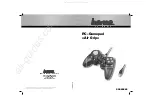
Using the Setup Utility
3-DNS
®
Administrator Guide
3 - 11
Configuring the 3-DNS mode
The 3-DNS Controller can run in three different modes: node, bridge, and
router.
◆
Node mode
The
node mode
is the traditional installation of the 3-DNS Controller.
The 3-DNS Controller replaces a DNS server in a network and uses the
DNS server’s IP address. All DNS traffic is directed at the 3-DNS
Controller because it is registered with InterNIC as authoritative for the
domain. In node mode, you usually run BIND on the system to manage
DNS zone files. In node mode, you may also use the NameSurfer
application available to manage your zone files.
◆
Bridge mode
In
bridge mode
, the 3-DNS Controller acts as an IP bridging device by
forwarding packets between two LAN segments (usually on the same IP
subnet). The system usually has one IP address, and is installed between
the router or switch, and the authoritative DNS server. The 3-DNS
Controller does not replace the authoritative DNS server.
The 3-DNS Controller filters all DNS packets that match wide IPs, and
forwards the remaining packets to the authoritative DNS server for
resolution. Note that this may be the preferred method of using the
3-DNS Controller because you do not have to replace the authoritative
DNS server, and you can perform out-of-band testing before you deploy
3-DNS software upgrades.
◆
Router mode
In
router mode
, the 3-DNS Controller acts as a router by forwarding
packets between two different IP subnets. You can put the 3-DNS
Controller anywhere in the network topology so that packets destined for
the authoritative DNS server have to pass through it. Router mode
requires at least two IP addresses and two VLANs. Router mode is
probably most useful for Internet service providers (ISPs) that want to
redirect traffic to local content servers. For example, by using the 3-DNS
Controller in router mode, an ISP can redirect requests for
ads.siterequest.net
to a local ad server.
Configuring user authentication
When you run the Setup utility, you can configure authentication for 3-DNS
user accounts either through an external LDAP or RADIUS server, or
locally on the 3-DNS Controller. The following sections describe these two
authentication options.
Note
The
root
and
admin
accounts are always authenticated locally.
Summary of Contents for 3-DNS
Page 1: ...3 DNS Administrator Guide version 4 5 MAN 0046 02 ...
Page 2: ......
Page 6: ...iv ...
Page 7: ...Table of Contents ...
Page 8: ......
Page 14: ......
Page 26: ...Chapter 1 1 12 ...
Page 28: ......
Page 42: ......
Page 60: ...Chapter 3 3 18 ...
Page 62: ......
Page 76: ...Chapter 4 4 14 ...
Page 78: ......
Page 96: ...Chapter 5 5 18 ...
Page 98: ......
Page 108: ......
Page 120: ......
Page 128: ...Chapter 8 8 8 ...
Page 130: ......
Page 136: ...Chapter 9 9 6 ...
Page 138: ......
Page 145: ...Glossary ...
Page 146: ......
Page 159: ...Index ...
Page 160: ......
















































